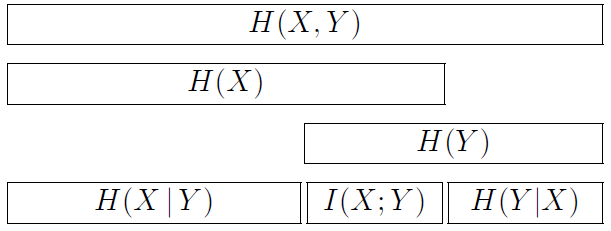
- •Inferring the input to a real channel
- •Inferring the mean and variance of a Gaussian distribution
- •Information content defined in terms of lossy compression
- •Information content of independent random variables
- •Information conveyed by a channel
- •Information types
- •Introduction to convolutional codes
Information conveyed by a channel
We now consider how much information can be communicated through a channel. In operational terms, we are interested in finding ways of using the channel such that all the bits that are communicated are recovered with negligible probability of error. In mathematical terms, assuming a particular input ensemble X, we can measure how much information the output conveys about the input by the mutual information:
I(X; Y) = H(X) – H(X | Y) = H(Y) – H(Y | X)
Our aim is to establish the connection between these two ideas. Let us evaluate I(X; Y) for some of the channels above.
Hint for computing mutual information
We will tend to think of I(X; Y) as H(X) – H(X | Y), i.e., how much the uncertainty of the input X is reduced when we look at the output Y . But for computational purposes it is often handy to evaluate H(Y)–H(Y | X) instead.

Example Consider the binary symmetric channel again, with f =0.15 and PX:{p0=0.9,p1=0.1}. We already evaluated the marginal probabilities P(y) implicitly above: P(y=0) = 0.78; P(y=1) = 0.22. The mutual information is:
I(X; Y) = H(Y) – H(Y | X)
What is H(Y | X)? It is defined to be the weighted sum over x of H(Y | x), but H(Y | x) is the same for each value of x: H(Y | x=0) is H2(0.15), and H(Y | x=1) is H2(0.15). So
I(X; Y) = H(Y) – H(Y | X) = H2(0.22) – H2(0.15) = 0.76 – 0.61 = 0.15 bits
This may be contrasted with the entropy of the source H(X) = H2(0.1) = 0.47 bits.
Note: here we have used the binary entropy function H2(p) = H(p; 1–p) = p log 1/p + (1 – p) log 1/(1–p).
Example And now the Z channel, with PX as above. P(y=1)=0.085.
I(X; Y) = H(Y) – H(Y | X) = H2(0.085) – [0.9 H2 (0) + 0.1 H2 (0.15)] = 0.42 – (0.1 × 0.61) = 0.36 bits
The entropy of the source, as above, is H(X) = 0.47 bits. Notice that the mutual information I(X; Y) for the Z channel is bigger than the mutual information for the binary symmetric channel with the same f.
The Z channel is a more reliable channel.
Information types
knowledge area (biologic, industry, financial, etc)
physical nature (acoustic, visual, gustatory)
Structural-measurement properties.
Parametric information – contains numerical evaluation of different properties.
Information types |
Key |
Information representation form |
||
Topologic |
Abstract |
Linguistic |
||
event value function complex ................ field |
Ф0 Ф1 Ф2 Ф3 ......... Фn |
point line surface volume .............. dimension
|
opinion idea image system ............. universe |
sign character word sentence ............... fund |
Information structure could be changed and reorganized on different dimentions.
